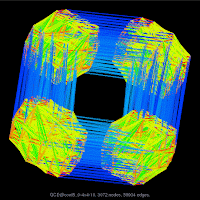Any people interested by sparse matrix algorithms should know the University of Florida sparse matrix collection and, by the way, Tim Davis. If you don't, please spend some time using the above links, it really worth it ! It collects many different kind of matrices, real, hermitian, symmetric, unsymmetric, rectangular, etc, etc. Moreover you have a nice colored view of each matrices obtained by spectral mapping and colouring. Could you guess for which kind of problem each of the matrices below arised ?
Yesterday evening, too bored by what TV was proposing to me, I decided to watch a conference of Mathias Fink , a french researcher working on multidisciplinary application of waves. Specially shear waves. Here is a brief summary of his talk. In solids, waves have two principal components: compression waves (P-waves for primary) moving in the direction of propagation, and shear waves (S-waves, for secondary) that make ripples in the plane orthogonal to that direction. Since compression waves propagate in the direction of propagation, they move faster than shear waves. Usually ultrasound equipment in medicine only use compressional waves. But since human tissues have a high bulk modulus, the P-wave speed is relatively constant (around 1580 m/s). Human tissues are very stiff if you apply isotropic constraints on them (like pressure of water). However M. Fink and his colleagues proposed a new way to investigate human tissues by first sending a strong compressional wave in ...






Comments